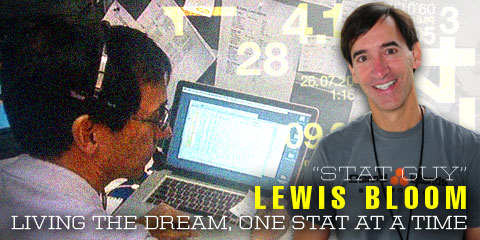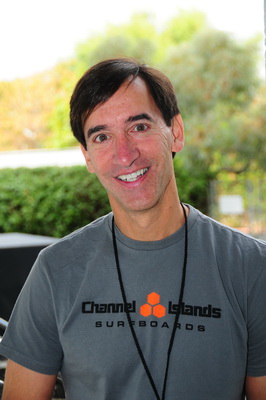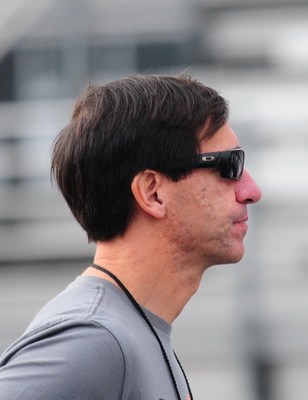STAT MAN LEWIS BLOOM: LIVING THE DREAM ONE STAT AT A TIME
 One trip to the drag strip was all the inspiration Lewis Bloom needed to become a drag racing addict. Growing up eight miles from the sounds of Raceway Park in Englishtown, NJ, the ten year old kid who would later become the official ESPN drag racing statistician, used to hear the sounds of the strip emanate every time he played tennis with his friends.
One trip to the drag strip was all the inspiration Lewis Bloom needed to become a drag racing addict. Growing up eight miles from the sounds of Raceway Park in Englishtown, NJ, the ten year old kid who would later become the official ESPN drag racing statistician, used to hear the sounds of the strip emanate every time he played tennis with his friends.He really didn’t know what was making those strange sounds.
The young Bloom asked his father for clarification, and the response was, “I think there’s a race track, do you want to go?”
On May 2, 1970, his eleventh birthday, Bloom received the present that would forever influence his life. The elder Bloom took him to the drag strip.
 One trip to the drag strip was all the inspiration Lewis Bloom needed to become a drag racing addict. Growing up eight miles from the sounds of Raceway Park in Englishtown, NJ, the ten year old kid who would later become the official ESPN drag racing statistician, used to hear the sounds of the strip emanate every time he played tennis with his friends.
One trip to the drag strip was all the inspiration Lewis Bloom needed to become a drag racing addict. Growing up eight miles from the sounds of Raceway Park in Englishtown, NJ, the ten year old kid who would later become the official ESPN drag racing statistician, used to hear the sounds of the strip emanate every time he played tennis with his friends.
He really didn’t know what was making those strange sounds.
The young Bloom asked his father for clarification, and the response was, “I think there’s a race track, do you want to go?”
On May 2, 1970, his eleventh birthday, Bloom received the present that would forever influence his life. The elder Bloom took him to the drag strip.
“I was just into cars, I liked drawing cars and I just liked cars,” said Bloom. “But he took me to the track and I saw drag racing for the first time and I was like oh my god, this is so cool and ended up buying every drag racing magazine I could possibly buy, which back then they were pretty cool magazines, you know Hot Rod, Car Craft, Drag Racing USA, Super Stock, and I just started reading everything and going to the races.”
Bloom immersed himself in the magazines, learning everything he could about automobiles and drag racing. He admits his father was not a gear head.
“My dad grew up in Brooklyn and he didn't drive a car until he was like 30, could care less about car, they just were transportation,” Bloom admitted. “Couldn't tell a Corvette from an Impala. So I didn't get it from him or my mom, I got it basically from that one trip to the track you know, and it was kind of a life changing day, when you think about it.”
The insatiable desire to learn more about drag racing wasn’t quenched by the magazines or the visits to Raceway Park. A 14-year old Bloom made the gamble of a lifetime and embarked on the second most influential drag racing moment in his life.
“I called the race track and spoke to Vinnie Napp,” Bloom explained. “I talked to him about drag racing for like two hours. And I was really just a precocious kid trying to find out who he was going to book in for different races.”
Napp picked up quickly on the inquisitive nature of the kid; after all, there weren’t many 14-year olds asking if he was booking in Don Garlits or Shirley Muldowney.
“He said, 'you really know what you're talking about,'” Bloom said. “I'll never forget that, he asked me if I was good at English, I was like why would that matter? He goes because well I think I'd like you to try announcing.”
Bloom was taken aback by Napp’s inquiry.
“I'm like, announcing?” Bloom asked. “I said you know, I don't have a driver's license, I've never been in the pits before. You couldn't get into the pits until you were 18. He says you know about drag racing, he said that's what it's about.”
Every career has a starting point, and for Bloom his debut was at the 1974 Funny Car Bonanza where he shared the microphone with “Beserko” Bob Doerrer, an Englishtown announcing legend.
“He was a huge influence,” said Bloom, of Doerrer. “He used to bust my chops but I learned a lot from him. He knew everybody too, which is the cool part. I got introduced to people when I was 15 years old that I never would have met otherwise.”  Two decades later, Bloom, then a staple of the Raceway Park announcing deck, joined the NHRA’s announcing staff. Because the talented Bloom was keen on the stats of the sport, he quickly found a niche on the ESPN coverage team as the official statistician.
Two decades later, Bloom, then a staple of the Raceway Park announcing deck, joined the NHRA’s announcing staff. Because the talented Bloom was keen on the stats of the sport, he quickly found a niche on the ESPN coverage team as the official statistician.
“They asked is there anybody who can do the statistics, and at the time I would only go to like 10 or 12 races, I wouldn't go to the whole series and I was hoping to get to go to every race because I thought that would be kinda cool,” he added.
Bloom initially shared the job with former NHRA announcer Bob Unkefer.
“We would split the season,” Bloom said. “I would announce half and he would do stats the other half and we'd split it. He'd be at a race and I'd be at a race and we'd split who would do statistics and who would do announcing.”
Bloom eventually became the exclusive full time stat man in 2007.
“The best way to say this is that Bob Frey is really the grand champion of statistics in drag racing because he, with the help of Rick Green [of DragRaceCentral.com], spent a lot of time creating files and programs to make all this stuff work. So I'm lucky enough that I get to use his basic data, which is a driver's career at every race.
“Back in the beginning of all this you'd actually manually have to update them after every race. I would do it and Bob would do it and we'd check each others to see if we had it right. But eventually Larry Sullivan and Rick figured out a program where literally everything goes right into the files and it's amazing how that all works. I could do my job without them, but nowhere near as good.”
And for Bloom, his job equates to living a dream. The passion of a child who heard strange noises in his Jersey neighborhood has yielded a career for one of drag racing’s most knowledgeable figures who found a niche with keeping history in his head.
“I've been a fan my whole life, so I remember things that happen and cars and moments cause it's just something I'm passionate about,” Bloom concluded.
Advertisement


